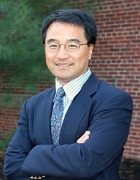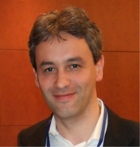1. Wireless Health: Opportunities, Challenges and Beyond
Abstract: The fast development and deployment of wireless communication technologies, such as 3G/4G/5G, and mobile devices, including sensors, robots, smartphones and pads, have significantly changed the way we study, live and work. Wireless health and innovative health technologies create an ideal platform for global partnerships striving to improve health and wellbeing, Wireless health systems are now capable of real-time, constant and widespread monitoring at home, work, or medical institutions. Such health technologies not only facilitate early-detection and rehabilitation, but also supply assistance for prevention of illness. In this talk, Dr. Shi will talk about the opportunities of wireless health, and share their experiences and lessons learned on several wireless health projects in the past six years.
 Weisong Shi
Weisong Shi
Program Director, NSF/CISE/CNS
Professor of Computer Science
Wayne State University
Director, Mobile and Internet Systems Laboratory (MIST)
Director, Wireless Health Initiative (WHI)
Bio: Weisong Shi is a Charles H. Gershenson Distinguished Faculty Fellow and a Professor of Computer Science at Wayne State University. There he directs the Mobile and Internet SysTems Laboratory (MIST) and the Wayne Wireless Health Initiative, investigating performance, reliability, power- and energy-efficiency, trust and privacy issues of networked computer systems and applications. Dr. Shi was on leave with the National Science Foundation as a Program Director in the Division of Computer and Network Systems, Directorate of Computer and Information Science and Engineering during 2013 – 2015, where he was responsible for the Computer and Network Systems (CNS) Core CSR Program, and two key crosscutting programs, including Cyber-Innovation for Sustainability Science and Engineering (CyberSEES), Smart and Connected Health (SCH). More information can be found at http://www.cs.wayne.edu/~weisong.
2. Sensors, Smartphones and Wearable Devices for Vital Sign, Atrial Fibrillation and Underwater ECG Monitoring
Abstract: An important step in improving preventative healthcare is to shift the focus from treating clinically apparent medical problems to preventing symptom progression through early detection and targeted intervention. In this new paradigm, integration of novel sensor technologies, wearable monitors, smartphones, information technologies, signal processing algorithms, and telecommunications have the potential to revolutionize healthcare. Current monitoring technologies to detect worsening health status are not user-friendly, reliable or affordably priced. A home-based vital sign monitor that integrates early detection and is designed to promote acceptance and cooperation by patients would have important clinical and research applications. To this end, this keynote talk will highlight some recent advances in wearable devices, novel sensors and medical software applications on smartphones that have the potential to provide accurate, reliable vital signs and specific cardiovascular diagnostics including detection of atrial fibrillation which affects more than 5 million Americans.
 Ki Chon
Ki Chon
Krenicki Professor of Biomedical Engineering & Department Head
Bronwell 217C, 260 Glenbrook Road, Unit 3247
University of Connecticut
Bio: Ki H. Chon received the B.S. degree in electrical engineering from the University of Connecticut, Storrs; the M.S. degree in biomedical engineering from the University of Iowa, Iowa City; and the M.S. degree in electrical engineering and the Ph.D. degree in biomedical engineering from the University of Southern California, Los Angeles. He spent three years as an NIH Post-Doctoral fellow at the Harvard-MIT Division of Health Science and Technology, one year as a Research Assistant Professor in the Department of Molecular Pharmacology, Physiology, and Biotechnology at Brown University, Providence, Rhode Island, and four years as an Assistant and Associate Professor in the Department of Electrical Engineering at the City College of the City University of New York. He then moved to the Department of Biomedical Engineering at SUNY Stony Brook as an Associate Professor and was promoted to a full professor. Most recently, he was a Professor and Chair of Biomedical Engineering at Worcester Polytechnic Institute, Worcester, MA. He is currently the John and Donna Krenicki Endowed Chair Professor and Head of Biomedical Engineering at University of Connecticut, Storrs, CT.
His current research interests include medical instrumentation, biomedical signal processing, wearable sensors and devices including use of smart phones for vital signs and monitoring cardiac arrhythmias, development of hydrophobic vital sign sensors and identification and modeling of physiological systems.
He has published more than 110 peer-reviewed journal articles to date and has 6 U.S. patents granted. His patent on real-time detection of atrial fibrillation algorithm has been licensed to a Holter company and the Holter is currently on the market.
He was an Associate Editor of the IEEE Transactions on Biomedical Engineering from 2007-2013. He has chaired many international conferences including his role as the Program Co-Chair for the IEEE EMBS conference in NYC in 2006, and as the Conference Chair for the 6th International Workshop on Biosignal Interpretation in New Haven, CT in 2009. He is a fellow of the American Institute of Medical and Biological Engineering and of the International Academy of Medical and Biological Engineering.
3. Tracking Vital Signs during Sleep Leveraging Mobile Devices
Abstract: Tracking human vital signs of breathing and heart rates during sleep is important as it can help to assess the general physical health of a person and provide useful clues for diagnosing possible diseases. Traditional approaches (e.g., Polysomnography (PSG)) are limited to clinic usage. Recent radio frequency (RF) based approaches require specialized devices or dedicated wireless sensors and are only able to track breathing rate. New studies using smartphone sensors for sleep monitoring can only detect coarse-grained sleep events such as body movement, cough and snore. We propose to track the vital signs of both breathing rate and heart rate during sleep by using mobile devices without any wearable or dedicated devices. Two novel approaches are developed: the first one is to exploit the readily available smartphone earphone placed close to the user to reliably capture the human breathing sound. Given the captured acoustic sound, our system performs noise reduction to remove environmental noise and then identifies the breathing rate based on the signal envelope detection. The second approach is re-uses existing WiFi network and exploits the fine-grained channel information to capture the minute movements caused by breathing and heart beats. Our system thus has the potential to be widely deployed and perform continuous long-term monitoring. The developed algorithm makes use of the channel information in both time and frequency domain to estimate breathing and heart rates, and it works well when either individual or two persons are in bed.
 Yingying (Jennifer) Chen
Yingying (Jennifer) Chen
Professor
Graduate Program Director of Information and Data Engineering (IDE)
Graduate Program Director of Networked Information Systems (NIS)
Department of Electrical and Computer Engineering
Stevens Institute of Technology
Bio: Yingying (Jennifer) Chen is a Professor in the Department of Electrical and Computer Engineering at Stevens Institute of Technology. She is the Director of Data Analysis and Information Security (DAISY) Lab at Stevens. She is also the Graduate Director of Information and Data Engineering (IDE) program. Her research interests include mobile and pervasive computing, cyber security and privacy, and smart healthcare. She received her Ph.D. degree in Computer Science from Rutgers University. She has coauthored the book Securing Emerging Wireless Systems and published over 90 journal articles and referred conference papers. She received early promotion with tenure at Stevens. Prior to joining Stevens Institute of Technology, she was with Alcatel-Lucent at Murray Hill. She received the IEEE Outstanding Contribution Award from IEEE New Jersey Coast Section each year 2005-2009. She is the recipient of the NSF CAREER award on wireless security and Google Faculty Research Award on mobile computing. She received Stevens Board of Trustees Award for Scholarly Excellence 2010 and the New Jersey Inventors Hall of Fame Innovators Award 2012. She is also the recipient of the Best Paper Awards of ACM MobiCom 2011 and IEE CNS 2014. She is serving on the journal editorial boards of IEEE Transactions on Mobile Computing (TMC), IEEE Transactions on Wireless Communications (TWC), IEEE Computer Network Magazine, and EURASIP Journal on Information Security. Her research has been reported by numerous media outlets including the Wall Street Journal, MIT Technology Review, Fox News Channel, Inside Science TV, Tonight Show with Jay Leno, National Public Radio (NPR), and CNET. For more information, please refer to: http://personal.stevens.edu/~ychen6/.
4. Toward Ultrasonically Networked Miniaturized Medical Implants
Abstract: Wirelessly networked systems of implantable sensors and actuators could enable revolutionary new applications with a potential to advance the medical treatment of major diseases of our times. Yet, most “body area networks” research to date has focused on communications among devices interconnected through electromagnetic radio-frequency (RF) waves (often along the body surface); while the key challenge of enabling networked intra-body miniaturized smart implants that communicate through body tissues is largely unaddressed. A key obstacle is posed by fact that the human body is composed primarily of water – a medium through which RF electromagnetic waves do not propagate well.
In this talk, I will give an overview of our ongoing work attempting to establish wireless communication links and networks through human tissues by means of acoustic waves at ultrasonic frequencies. We will discuss fundamental aspects of ultrasonic propagation in human tissues and their impact on wireless protocol design at different layers of the protocol stack. We will then discuss our progress in designing and prototyping embedded systems with ultrasonic communication capabilities.
 Tommaso Melodia
Tommaso Melodia
Associate Professor
Department of Electrical and Computer Engineering
Northeastern University
422 Dana Hall, Boston, MA 02115
Bio: Tommaso Melodia is an Associate Professor with the Department of Electrical and Computer Engineering at Northeastern University in Boston. He received his Ph.D. in Electrical and Computer Engineering from the Georgia Institute of Technology in 2007. He is a recipient of the National Science Foundation CAREER award, and coauthored a paper that was recognized as the ISI Fast Breaking Paper in the field of Computer Science for February 2009 and of an ACM WUWNet 2013 Best Paper Award. He serves in the Editorial Boards of IEEE Transactions on Mobile Computing, IEEE Transactions on Wireless Communications, IEEE Transactions on Multimedia, and Computer Networks (Elsevier). His current research interests are in modeling, optimization, and experimental evaluation of networked communication systems, with applications to ultrasonic intra-body networks, cognitive and cooperative networks, multimedia sensor networks, and underwater networks.
5. GEOLOCATION of RF Signals
Abstract: Principles and Simulations offers an overview of the best practices and innovative techniques in the art and science of geolocation over the last twenty years. It covers all research and development aspects including theoretical analysis, RF signals, geolocation techniques, key block diagrams, and practical principle simulation examples in the frequency band from 100 MHz to 18 GHz or even 66 GHz. Dr. Progri reveals the research and development process by demonstrating how to understand and explain geolocation of RF signals from basic diagrams to the final principle simulation examples and make recommendations for the future final products of geolocation of RF signals. Starting with RF signals, the tutorial progressively examines various signal bands – such as VLF, LF, MF, HF, VHF, UHF, L, S, C, X, Ku, and, K and the corresponding geolocation requirements per band and per application – to achieve required performance objectives of up to 0º precision. Next follows a step-by-step approach of RF geolocation techniques and concludes with notes on state-of-the-art geolocation designs as well as advanced features found in signal generator instruments. The tutorial also includes the best mathematical techniques employed for geolocation of RF signals at 100 MHz to 18 GHz or even 66 GHz.
 Dr. Ilir Progri
Dr. Ilir Progri
Chairman, CEO, and President
Giftet Inc.
5 Euclid. Ave. Apt. 3
Worcester, MA 01610
Bio: Dr. Ilir Progri is a world renowned pioneer leading authority in Geolocation/GPS/GNSS/Global Wireless Communications in all aspects of significantly improved signal specifications, simulation, software development, and implementation. He has: (1) two pioneer book publications, one patent, six world class tutorials, and over eighty five published referred journal/magazine articles, conference publications, tutorials, etc. in all aspects of geolocation, RF geolocation, geo-intelligence, and geo-reference systems; (2) received recognition by over two hundred and six publications: (a) eleven book authors; (b) thirty-three peer review IEEE journal paper and/or magazine article author(s); (c) three peer review IEE or IET journal paper and/or magazine article author(s); (d) eighteen peer-review Navigation/JGPS/springer/Wiley/ Hindawi/ PIERS Online J. Papers and/or Magazine Articles ; (e) forty-five peer review other journal paper and/or magazine article author(s); (f) sixteen peer review newsletter article author(s); (g) ten patent inventors; (h) eighteen Ph.D. dissertation student scholars; (i) ten M.S. thesis student scholars;(j) one Diploma of Engineer student scholar; and (k) forty-one conference proceedings authors; i.e., eighty percent from high quality peer review publications from scientists of US, Canada, Australia, UK, Finland, France, Italy, Germany, Russia, China, Croatia, Japan, Spain, Switzerland, Singapore, Korea, Taiwan, Hong Kong, Egypt, etc. He is currently the Chairman, CEO, and President of Giftet Inc. [www.giftet.com]. He is a FRIN, SM IEEE, and MION. He is the Editor-in-Chief (EIC) & Scientific Editor of the Journal of Geolocation, Geo-information and Geo-intelligence of http://www.giftet.com/uploads/3/5/1/1/3511542/giftet_jg3.pdf.





